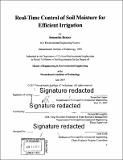| dc.contributor.advisor | Dennis McLaughlin. | en_US |
| dc.contributor.author | Harper, Samantha (Samantha E.) | en_US |
| dc.contributor.other | Massachusetts Institute of Technology. Department of Civil and Environmental Engineering. | en_US |
| dc.date.accessioned | 2017-09-15T15:37:19Z | |
| dc.date.available | 2017-09-15T15:37:19Z | |
| dc.date.copyright | 2017 | en_US |
| dc.date.issued | 2017 | en_US |
| dc.identifier.uri | http://hdl.handle.net/1721.1/111509 | |
| dc.description | Thesis: M. Eng., Massachusetts Institute of Technology, Department of Civil and Environmental Engineering, 2017. | en_US |
| dc.description | Cataloged from PDF version of thesis. Page 52 blank. | en_US |
| dc.description | Includes bibliographical references (pages 31-34). | en_US |
| dc.description.abstract | In the field of precision irrigation control, two classes of controllers have emerged - classical controllers and model based controllers. The most widely-used real-time closed-loop controller is a bang-bang controller that applies water at a predetermined rate, duration, and minimum soil moisture. Due to the ease of installation of soil moisture sensors, this technology has been installed around the world. There have been few studies on altering the controller used with this existing infrastructure. This thesis articulates a model for using a real-time proportional-integral-derivative (PID) controller to minimize water use using HYDRUS- 1D, a software package for simulating the one-dimensional movement of water, heat, and solutes in porous media, to simulate soil moisture. In a direct comparison between the two controllers, the PID controller uses less water. However, small violations of the target soil moisture and optimization of the PID parameters present the current barrier to implementation of this technology. Maintaining soil moisture at or above minimal depletion is critical to support crop health throughout a growing season. PID controllers offer a mid-point between the simplistic bang-bang controllers and the model based controllers that require large datasets, wireless network infrastructure, and robust computing systems. With proper calibration, PID controllers can be implemented in the field with the same sensors that are widely used with bang-bang controllers resulting in a reduction of water use in regions where water is scarce. | en_US |
| dc.description.statementofresponsibility | by Samantha Harper. | en_US |
| dc.format.extent | 52 pages | en_US |
| dc.language.iso | eng | en_US |
| dc.publisher | Massachusetts Institute of Technology | en_US |
| dc.rights | MIT theses are protected by copyright. They may be viewed, downloaded, or printed from this source but further reproduction or distribution in any format is prohibited without written permission. | en_US |
| dc.rights.uri | http://dspace.mit.edu/handle/1721.1/7582 | en_US |
| dc.subject | Civil and Environmental Engineering. | en_US |
| dc.title | Real-time control of soil moisture for efficient irrigation | en_US |
| dc.type | Thesis | en_US |
| dc.description.degree | M. Eng. | en_US |
| dc.contributor.department | Massachusetts Institute of Technology. Department of Civil and Environmental Engineering | |
| dc.identifier.oclc | 1003324142 | en_US |
